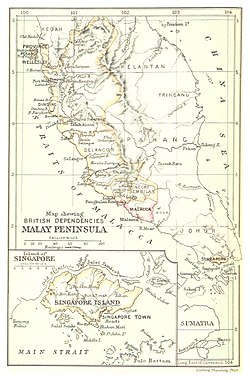
Back مالايا البريطانية Arabic Malasia británica AST Брытанская Малая Byelorussian Britské Malajsko Czech Britisk Malaya Danish British Malaya German Brita Malajzio Esperanto Malasia británica Spanish مالایای بریتانیا Persian Malaisie britannique French
British Malaya Tanah Melayu British (Malay) | |||||||||||||||||||||||||
|---|---|---|---|---|---|---|---|---|---|---|---|---|---|---|---|---|---|---|---|---|---|---|---|---|---|
| 1826–1942 1942–1945 (Japanese occupation) 1945–1957 | |||||||||||||||||||||||||
| Anthem: "God Save the King/Queen" | |||||||||||||||||||||||||
 British dependencies in Malaya and Singapore, 1888 | |||||||||||||||||||||||||
| Demonym(s) | Malayan | ||||||||||||||||||||||||
| Membership | |||||||||||||||||||||||||
| Government | Imperial | ||||||||||||||||||||||||
• 1826–1830 | George IV | ||||||||||||||||||||||||
• 1830–1837 | William IV | ||||||||||||||||||||||||
• 1837–1901 | Victoria | ||||||||||||||||||||||||
• 1901–1910 | Edward VII | ||||||||||||||||||||||||
• 1910–1936 | George V | ||||||||||||||||||||||||
• 1936–1936 | Edward VIII | ||||||||||||||||||||||||
• 1936–1942 | George VI | ||||||||||||||||||||||||
• 1942–1945 | Interregnum | ||||||||||||||||||||||||
• 1945–1952 | George VI | ||||||||||||||||||||||||
• 1952–1957 | Elizabeth II | ||||||||||||||||||||||||
| Legislature | Parliament | ||||||||||||||||||||||||
| House of Lords | |||||||||||||||||||||||||
| House of Commons | |||||||||||||||||||||||||
| History | |||||||||||||||||||||||||
| 17 March 1824 | |||||||||||||||||||||||||
| 27 November 1826 | |||||||||||||||||||||||||
| 20 January 1874 | |||||||||||||||||||||||||
| 15 February 1942 – 2 September 1945 | |||||||||||||||||||||||||
| 12 September 1945 | |||||||||||||||||||||||||
| 1 April 1946 | |||||||||||||||||||||||||
| 1 February 1948 | |||||||||||||||||||||||||
| 16 June 1948 | |||||||||||||||||||||||||
| 18 January 1956 | |||||||||||||||||||||||||
| 31 July 1957 | |||||||||||||||||||||||||
| 31 August 1957 | |||||||||||||||||||||||||
| |||||||||||||||||||||||||
| History of Malaysia |
|---|
 |
|
|
The term "British Malaya" (/məˈleɪə/; Malay: Tanah Melayu British) loosely describes a set of states on the Malay Peninsula and the island of Singapore that were brought under British hegemony or control between the late 18th and the mid-20th century. Unlike the term "British India", which excludes the Indian princely states, British Malaya is often used to refer to the Federated and the Unfederated Malay States, which were British protectorates with their own local rulers, as well as the Straits Settlements, which were under the sovereignty and direct rule of the British Crown, after a period of control by the East India Company.
Before the formation of the Malayan Union in 1946, the territories were not placed under a single unified administration, with the exception of the immediate post-war period when a British military officer became the temporary administrator of Malaya. Instead, British Malaya comprised the Straits Settlements, the Federated Malay States, and the Unfederated Malay States. Under British hegemony, Malaya was one of the most profitable territories of the empire, being the world's largest producer of tin and later rubber. During the Second World War, Japan ruled a part of Malaya as a single unit from Singapore.[1]
The Malayan Union was unpopular and in 1948 was dissolved and replaced by the Federation of Malaya, which became fully independent on 31 August 1957. On 16 September 1963, the federation, along with North Borneo (Sabah), Sarawak, and Singapore, formed the larger federation of Malaysia.[2]
- ^ Cheah Boon Kheng 1983, p. 28.
- ^ C. Northcote Parkinson (June 1956). "The British in Malaya". History Today. 6 (6): 367–375.
